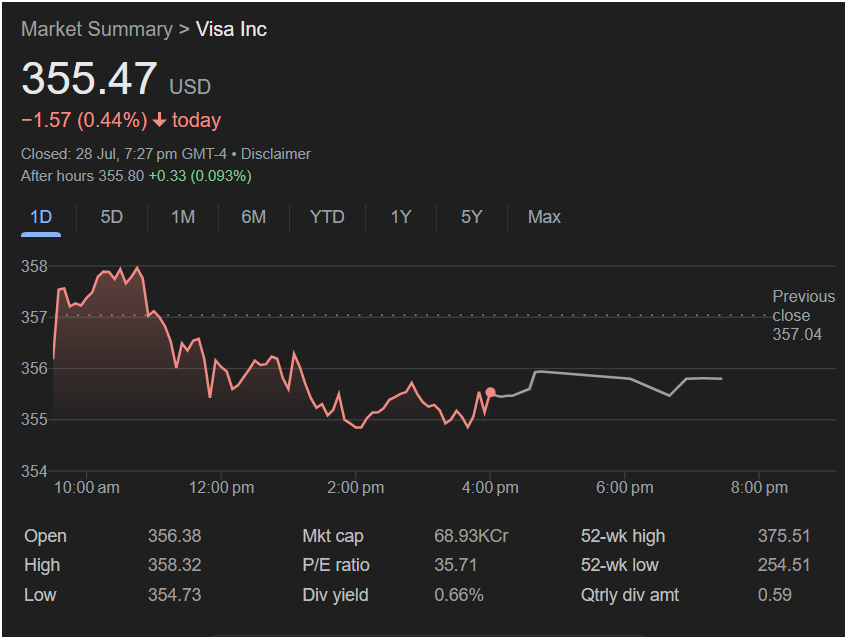Visa Stock (V) Sees Modest Pullback, Investors Weigh Economic Cues

NEW YORK – Shares of the global payments technology giant Visa Inc. (NYSE: V) experienced a slight downturn in a volatile trading session on Friday, closing in negative territory as investors appeared to take some profits off the table following a recent run-up. The stock, a key barometer for consumer spending health, ended the day at
1.57, or 0.44%.
Despite the daily loss, there were signs of resilience. In after-hours trading, Visa’s stock showed a minor recovery, ticking up $0.33 (0.093%) to $355.80, suggesting that buying interest may be re-emerging at these levels.
A Closer Look at the Day’s Trading
The session for Visa was a tale of two halves. The stock opened at $356.38, slightly below the previous close of
358.32** in the morning. However, this early strength faded as the day progressed. Selling pressure mounted, pushing the shares steadily downward to a session low of $354.73 before a slight consolidation into the close.
This price action indicates a pullback from the stock’s recent strength, a common occurrence in markets as traders and investors re-evaluate positions. For a blue-chip company like Visa, whose performance is intrinsically linked to the pulse of global commerce, such daily fluctuations are often scrutinized for clues about the broader economic outlook. Analysts frequently watch consumer spending data, retail sales figures, and travel trends, all of which are direct drivers of Visa’s transaction volumes and revenue. A dip in the stock, however modest, can sometimes reflect wider concerns about a potential slowdown in these areas.
Valuation and Shareholder Returns in Focus
From a valuation perspective, Visa remains a solidly positioned company. Its Price-to-Earnings (P/E) ratio stands at a healthy 35.71. This figure, while above the average for the broader market, is typical for a dominant, high-growth technology and financial services leader, indicating that investors are willing to pay a premium for its consistent performance and market leadership.
For income-oriented investors, Visa continues to provide a steady return. The company offers a dividend yield of 0.66%, based on a quarterly dividend payment of $0.59 per share. This practice of returning capital to shareholders, combined with its strong growth profile, makes Visa a staple in many long-term investment portfolios.
The stock is currently trading closer to its 52-week high of $375.51 than its 52-week low of $254.51. This positioning suggests that despite the day’s dip, the overall trend for the past year has been positive. The key question for market participants now is whether this pullback is a temporary consolidation before the next move higher or the beginning of a more significant correction.
As a new week of trading approaches, investors will be closely monitoring key economic indicators and overall market sentiment. The behavior of Visa’s stock will continue to be a significant tell-tale sign of the health of the consumer and the global economy at large. The market will be watching to see if the stock can find support near its recent lows or if it will test higher resistance levels in the coming days.

